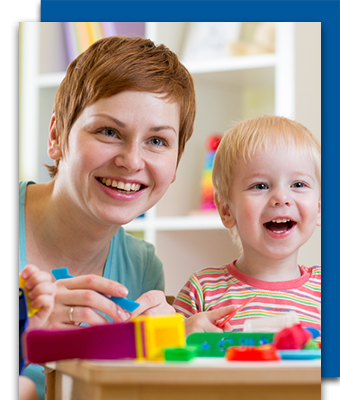Learning to speak is a crucial part of a child’s development and the most intensive period of speech and language development happens in the first three years of life.
Even though children vary in their development of speech and language, there are certain ‘milestones’ that can be identified as a rough guide to normal development. Typically, these skills must be reached at certain ages before more complex skills can be learned. These milestones help speech pathologists determine if a child may need extra help to learn to speak or use language.

During their first year, children develop the ability to hear and recognise the sounds of their parents’ language. They experiment with sounds by babbling (e.g. “baba”, “babamada”), and over time, their babbling begins to sound more and more like real words.
What can most babies do?
- Between 0-3 months babies communicate by crying, cooing, smiling, and making eye contact
- Between 3-6 months babies communicate by crying, cooing, smiling, making eye contact, pointing, blowing raspberries and laughing
- Between 6-9 months babies communicate by babbling, using sounds made with the lips (e.g. b and m) in sequences like “baba” and later “bamada”
- Between 9-12 months babies communicate by babbling, using more sounds (e.g. d, m, n, h, w, t)
- Around 12 months babies begin to use words
What do many babies still find difficult?
Babies can’t say words the same way as adults do and often simplify words (e.g. biscuit becomes “bi”).
Toddlers experience a huge development in speech sounds and triple the number of words they can say between 1and 2 years of age. As a result, their speech becomes easier to understand. At 2 years, half of their speech should be understood, and at 3 years, most of their speech should be understood by family and friends.
What can most toddlers do?
- By 2 years, toddlers can say a range of speech sounds when talking (e.g. p, b, m, t, d, n, h, w)
- By 3 years, toddlers can say even more sounds (e.g. k, g, f, s, ng)
What do many toddlers still find difficult?
Many toddlers have difficulty saying sounds correctly all the time. Some words are more difficult than others for children to say, so they may make some sound errors (e.g. “tat” for cat and “pam” for pram). Sometimes, children can be more difficult to understand when they are using longer sentences.
Preschool children start to use much longer sentences, yet their speech should still be understood by unfamiliar people (outside of the family) about 75% of the time. By 5 years of age, anyone (including unfamiliar listeners) should be able to understand the child’s speech in conversation 95-100% of the time.
What can most children do?
-
- By 4 years, children can say most sounds correctly (e.g., m, n, h, w, p, b, t, d, k, g, ng, f, y, s, z, ch, j, sh, l). They can use many consonant clusters, which are combinations of two or more sounds (e.g., tw, sp, gl). Children may use clusters at the start (e.g., blue) or end of words (e.g., hand). Also, children will say most vowel sounds in words correctly (e.g., ay, oh, ee).
- Between 4-5 years, preschool children start to develop skills that will be important for learning to read and write (called “pre-literacy skills”). They become aware that spoken words can rhyme (e.g., cat – bat), and can be broken into syllables/beats (e.g., am-bu-lance).
What do many children still find difficult?
- Some sounds are later to develop and children may still have difficulty with them at this age. For instance, preschool children commonly have difficulty with “r” (e.g., saying “wed” for red), “v” (e.g., saying “berry” for very), and “th” (e.g., saying “fank you” for thank you)
- Some children are still developing the ability to use consonant clusters (e.g., scribble and strawberry), or to say all the sounds correctly in longer words (e.g., caterpillar and spaghetti). Some children may still produce “s” as “th” (e.g., a lisp)
When children commence school, their speech should be easily understood by everyone.
What can most children do at this age?
- Be able to say all the sounds well and be starting to recognise that spoken sounds can be matched to written letters.
- Hear and make rhyming words, hear and count syllables/beats in words, and make sentences with words that start with the same sound (e.g., big brown bear). Children can tell you what the first sound is in their name and what the letter is called and can break up the sounds in a small word (e.g., “c-a-t”).
What do many children still find difficult?
Children might still have trouble with “th” sounds (e.g., thumb, this) until 8-9 years, and might have difficulty saying sounds such as “s” and “z” when their front teeth fall out.
Children can produce clusters of sounds together, but may still have trouble with individual sounds (e.g., such as /r/ and /l/) in consonant clusters (e.g., “scwatch” for scratch) or in longer words (e.g., hippopotamus, pumpkin).